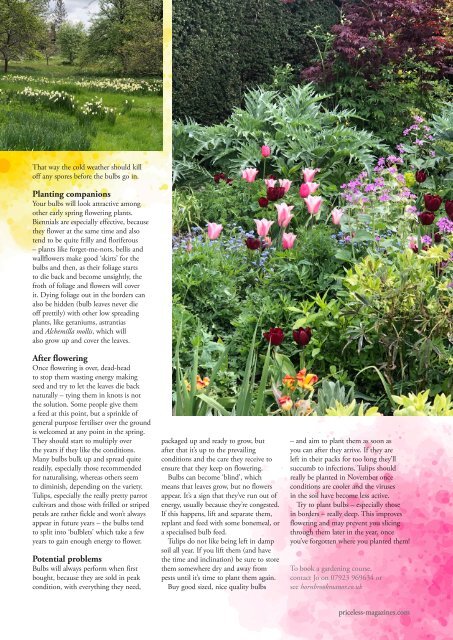Surrey Homes | SH105 | October 2023 | Interiors & Bathrooms Supplement inside
The lifestyle magazine for Surrey - Inspirational Interiors, Fabulous Fashion, Delicious Dishes
The lifestyle magazine for Surrey - Inspirational Interiors, Fabulous Fashion, Delicious Dishes
Create successful ePaper yourself
Turn your PDF publications into a flip-book with our unique Google optimized e-Paper software.
That way the cold weather should kill<br />
off any spores before the bulbs go in.<br />
Planting companions<br />
Your bulbs will look attractive among<br />
other early spring flowering plants.<br />
Biennials are especially effective, because<br />
they flower at the same time and also<br />
tend to be quite frilly and floriferous<br />
– plants like forget-me-nots, bellis and<br />
wallflowers make good ‘skirts’ for the<br />
bulbs and then, as their foliage starts<br />
to die back and become unsightly, the<br />
froth of foliage and flowers will cover<br />
it. Dying foliage out in the borders can<br />
also be hidden (bulb leaves never die<br />
off prettily) with other low spreading<br />
plants, like geraniums, astrantias<br />
and Alchemilla mollis, which will<br />
also grow up and cover the leaves.<br />
After flowering<br />
Once flowering is over, dead-head<br />
to stop them wasting energy making<br />
seed and try to let the leaves die back<br />
naturally – tying them in knots is not<br />
the solution. Some people give them<br />
a feed at this point, but a sprinkle of<br />
general purpose fertiliser over the ground<br />
is welcomed at any point in the spring.<br />
They should start to multiply over<br />
the years if they like the conditions.<br />
Many bulbs bulk up and spread quite<br />
readily, especially those recommended<br />
for naturalising, whereas others seem<br />
to diminish, depending on the variety.<br />
Tulips, especially the really pretty parrot<br />
cultivars and those with frilled or striped<br />
petals are rather fickle and won’t always<br />
appear in future years – the bulbs tend<br />
to split into ‘bulblets’ which take a few<br />
years to gain enough energy to flower.<br />
Potential problems<br />
Bulbs will always perform when first<br />
bought, because they are sold in peak<br />
condition, with everything they need,<br />
packaged up and ready to grow, but<br />
after that it’s up to the prevailing<br />
conditions and the care they receive to<br />
ensure that they keep on flowering.<br />
Bulbs can become ‘blind’, which<br />
means that leaves grow, but no flowers<br />
appear. It’s a sign that they’ve run out of<br />
energy, usually because they’re congested.<br />
If this happens, lift and separate them,<br />
replant and feed with some bonemeal, or<br />
a specialised bulb feed.<br />
Tulips do not like being left in damp<br />
soil all year. If you lift them (and have<br />
the time and inclination) be sure to store<br />
them somewhere dry and away from<br />
pests until it’s time to plant them again.<br />
Buy good sized, nice quality bulbs<br />
– and aim to plant them as soon as<br />
you can after they arrive. If they are<br />
left in their packs for too long they’ll<br />
succumb to infections. Tulips should<br />
really be planted in November once<br />
conditions are cooler and the viruses<br />
in the soil have become less active.<br />
Try to plant bulbs – especially those<br />
in borders – really deep. This improves<br />
flowering and may prevent you slicing<br />
through them later in the year, once<br />
you’ve forgotten where you planted them!<br />
To book a gardening course,<br />
contact Jo on 07923 969634 or<br />
see hornbrookmanor.co.uk<br />
priceless-magazines.com


















